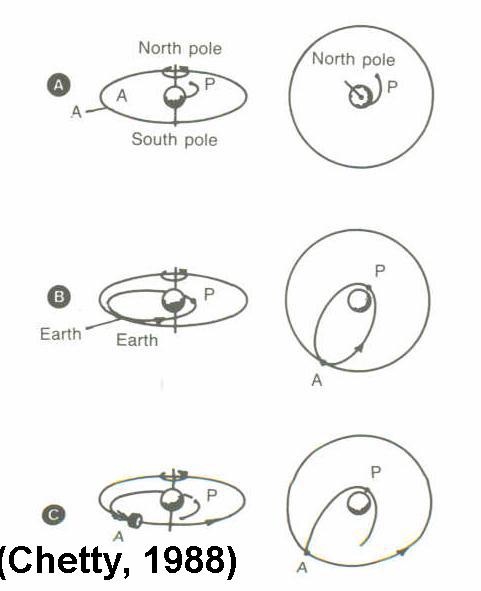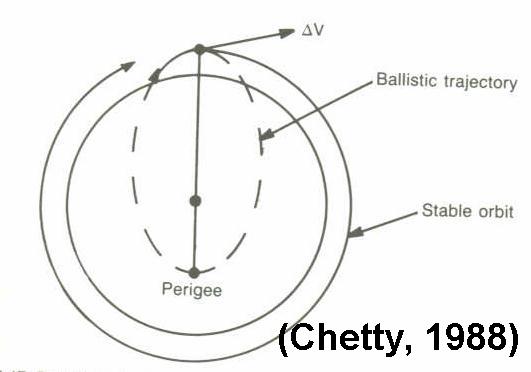Satellite Orbits
 Satellites are launched into several
types of orbits around the earth depending on their size, function, etc. (see
diagram on the right) In order for a satellite to maintain orbit, it must travel
at a velocity great enough to match the force of gravity pulling the object in. F=G(Mem/r2)
(where G is the universal gravitational constant, Me and m are the
masses of the Earth and satellite respectively, and r is the distance between
the two center of masses) For satellites in lower Earth orbits (LEO), they must
travel at very high velocities in order to escape the forces of gravity. (i.e.
17,500 mph) These satellites are usually smaller and limited in function.
Satellites in medium Earth orbits (MEO) are usually communication, and
navigation satellites which travel in elliptical orbits in various angles around
the poles. Geostationary Earth orbits (GEO) orbit the earth in exactly one day
and thus are always above one specific spot all the time above the equator.
These satellites are largely used for communications because they are always
available to relay signals to specific land-based receivers and a few of them
can cover the entire surface of the Earth. (Boeing, 2004)
Satellites are launched into several
types of orbits around the earth depending on their size, function, etc. (see
diagram on the right) In order for a satellite to maintain orbit, it must travel
at a velocity great enough to match the force of gravity pulling the object in. F=G(Mem/r2)
(where G is the universal gravitational constant, Me and m are the
masses of the Earth and satellite respectively, and r is the distance between
the two center of masses) For satellites in lower Earth orbits (LEO), they must
travel at very high velocities in order to escape the forces of gravity. (i.e.
17,500 mph) These satellites are usually smaller and limited in function.
Satellites in medium Earth orbits (MEO) are usually communication, and
navigation satellites which travel in elliptical orbits in various angles around
the poles. Geostationary Earth orbits (GEO) orbit the earth in exactly one day
and thus are always above one specific spot all the time above the equator.
These satellites are largely used for communications because they are always
available to relay signals to specific land-based receivers and a few of them
can cover the entire surface of the Earth. (Boeing, 2004)
In order for satellites to enter a stable desired orbit, they are launched in an
initial elliptical orbit about the earth. Once the satellite reaches the apogee
(furthest point from the Earth) of the orbit, a thruster is launched to boost
the satellite into the desired orbit. (see the two diagrams below). (Chetty,
1988)


 If a spacecraft is orbiting at a velocity equal to the velocity needed to
maintain a circular velocity, it will travel in a circular path; if it increases
its velocity, it will enter an elliptical orbit, and if it reaches an escape
velocity, it will escape planetary orbit with a parabolic trajectory;
furthermore, if it accelerates to a really high velocity, it will escape with a
hyperbolic trajectory. (see diagram to left) (Nicolson, 1978)
If a spacecraft is orbiting at a velocity equal to the velocity needed to
maintain a circular velocity, it will travel in a circular path; if it increases
its velocity, it will enter an elliptical orbit, and if it reaches an escape
velocity, it will escape planetary orbit with a parabolic trajectory;
furthermore, if it accelerates to a really high velocity, it will escape with a
hyperbolic trajectory. (see diagram to left) (Nicolson, 1978)
Similarly, when reentering the atmosphere, spacecraft must approach at a small
critical angle such that they do not get pulled in by gravity too quickly or
they will burn up from friction in the atmosphere. In addition, they cannot
enter too shallowly or they will "bounce" off the atmosphere similarly to a rock
skipping on water and may enter an orbit unsafe for reentry, or worse, get flung
into a parabolic orbit. Atmospheric skipping could however be used to reenter at
a certain desired landing site. (Alexandria, 1989)
Satellite orbits are more complicated than illustrated above however. Satellites
must account for many things including time dilation, some drag and spin
deviations. Lower Earth orbits are most effected by drag forces created by the
atmosphere. The lifetime of a satellite is dependant on the atmospheric density
through the orbit, the size, shape and mass of the satellite as well as the
initial orbit itself. (Chetty, 1988)
To counter satellite orbit
decay, many modern satellites are equipped with altitude control systems. These
altitude control systems include 3-axis stabilizers which allow for fine-point
control, spin stabilizers, gravity gradient stabiles which require long booms,
solar radiation stabilizers which are generally used in distant orbits because
they are weaker and slower, and magnetic stabiles which can be used close to the
Earth, but only allow for course alignment and are slow. (Chetty, 1988)



 Satellites are launched into several
types of orbits around the earth depending on their size, function, etc. (see
diagram on the right) In order for a satellite to maintain orbit, it must travel
at a velocity great enough to match the force of gravity pulling the object in. F=G(Mem/r2)
(where G is the universal gravitational constant, Me and m are the
masses of the Earth and satellite respectively, and r is the distance between
the two center of masses) For satellites in lower Earth orbits (LEO), they must
travel at very high velocities in order to escape the forces of gravity. (i.e.
17,500 mph) These satellites are usually smaller and limited in function.
Satellites in medium Earth orbits (MEO) are usually communication, and
navigation satellites which travel in elliptical orbits in various angles around
the poles. Geostationary Earth orbits (GEO) orbit the earth in exactly one day
and thus are always above one specific spot all the time above the equator.
These satellites are largely used for communications because they are always
available to relay signals to specific land-based receivers and a few of them
can cover the entire surface of the Earth. (Boeing, 2004)
Satellites are launched into several
types of orbits around the earth depending on their size, function, etc. (see
diagram on the right) In order for a satellite to maintain orbit, it must travel
at a velocity great enough to match the force of gravity pulling the object in. F=G(Mem/r2)
(where G is the universal gravitational constant, Me and m are the
masses of the Earth and satellite respectively, and r is the distance between
the two center of masses) For satellites in lower Earth orbits (LEO), they must
travel at very high velocities in order to escape the forces of gravity. (i.e.
17,500 mph) These satellites are usually smaller and limited in function.
Satellites in medium Earth orbits (MEO) are usually communication, and
navigation satellites which travel in elliptical orbits in various angles around
the poles. Geostationary Earth orbits (GEO) orbit the earth in exactly one day
and thus are always above one specific spot all the time above the equator.
These satellites are largely used for communications because they are always
available to relay signals to specific land-based receivers and a few of them
can cover the entire surface of the Earth. (Boeing, 2004)